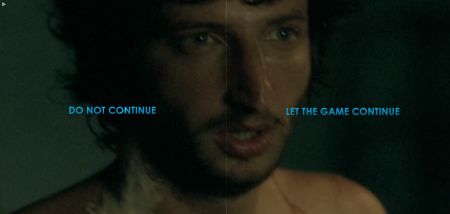von Roland Hachmann | Mai 16, 2007 | Blog, Digital Culture, Marketing Trends
A TechCrunch post on the new Pew Internet & American Life Project study mentions the increasing digital divide amongst the internet use population in the US. One thing I found quite funny was the name for the 8% top internet users. They’re called omnivores, because they consume everything, no questions asked.
8% of people are considered to be “omnivores†which the study describes as being Web 2.0 devotes, highly engaged with video online and digital content; “creative participants in cyberspaceâ€.
That’s me, I guess!
von Roland Hachmann | Mai 16, 2007 | Blog, Digital Marketing, Digital News, Online Advertising
A nice idea: In this movie by Axe, you can choose 2 or 3 times, which way the story of the movie should continue. Should the guy go with the girl(s), or should he resist and go home?

Naturally, the movie only ends well, if you click on „continue“ each time, so that the guy gets off with all the girls that lure him away.
Since I have a decent broadband line, I can watch the movie in good quality in almost full screen mode! Amazing, how this has evolved from the small thumbnail sized ads a few years back.
(found on adverblog.)
von Roland Hachmann | Mai 15, 2007 | Ad News, Blog, Digital Marketing, Digital News
- While everyone is getting excited about Joost, there is a competitor not far away. Less beta users, less headlines, but very similar thing, called babelgum.
- But that’s not all, Zattoo is another TV platform, with only few, but real TV stations, such as RTL, ART, BBC World, CNN, France 2+3, ZDF and some more.
- Audi.de/tv launched, and German Werbeblogger has some justified serious criticism about this web1.0-ish wannabe 2.0-ish plattform.
- Focus.de published a study about us german bloggers, finding out that we’re indeed young and well educated. Thanks for the compliment!
- The Playboy seems to be opening up a dependence in Second Life. I am curious to see their hostesses!
- Absolutely amazing: watching new flickr photos being uploaded, almost in real time – around the world: this is flickrvision, another API-wonder.
von Roland Hachmann | Mai 15, 2007 | Blog, Digital Marketing, Marketing, Online Advertising
This is an excellent execution for an anti-drug campaign from Norway! Showing the effects of drug abuse by visualising the effects on the microsite itself – making it really „tangible“.
On the Marihuana example, everything is blurred and your mousepointer gets annoyingly slow, while it gets incredibly fast and uncontrollable in the cocaine example. And with heroine, everything on the screen looks really shaky and frightening.

The site also opens several pop-unders for bancruptcy sites, memorial sites, etc. all related to possible results of your drug abuse. And when you try to close an example, there is a mockup pretending to notify the police, displaying your IP number, internet provider, etc.
Really well done!
(found on Adverblog.)
von Roland Hachmann | Mai 15, 2007 | Blog, Digital Culture, Digital Marketing, Digital News
Something for the German readers of this blog. German weekly magazine „Focus“ shows video interviews with celebrities of the digital world. I suppose these videos were made during this years DLD conference.

You can find names like Marissa Mayer, Lars Hinrichs, Arianna Huffington, Caterina Fake, John Naisbitt, Bruce Sterling, etc. Well worth watching, they’re short enough, only a few minutes each.
von Roland Hachmann | Mai 14, 2007 | Blog, Digital Culture, Marketing Trends, Social Media Marketing
So this how people get alienated these days: by having too many digital connections with others. Says this article on Forbes.
Thanks to technology, people have never been more connected–or more alienated
There is a lot of Klischee stuff in that article, but yet some good quotes:
The self that grows up with multitasking and rapid response measures success by calls made, e-mails answered and messages responded to.
We live a contradiction: Insisting that our world is increasingly complex, we nevertheless have created a communications culture that has decreased the time available for us to sit and think, uninterrupted.
One thought, though, takes it a little over the top, I think:
One says, „I don’t have enough time alone with my mind“; another, „I artificially make time to think.“ Such formulations depend on an „I“ separate from the technology, a self that can put the technology aside so as to function apart from its demands. But it’s in conflict with a growing reality of lives lived in the presence of screens, whether on a laptop, palmtop, cell phone or BlackBerry. We are learning to see ourselves as cyborgs, at one with our devices. To put it most starkly: To make more time means turning off our devices, disengaging from the always-on culture. But this is not a simple proposition, since our devices have become more closely coupled to our sense of our bodies and increasingly feel like extensions of our minds.
(found on the „cult of the amateur“ blog.)
von Roland Hachmann | Mai 14, 2007 | Ad News, Blog
There is a new technology, that counts the eyeballs that are viewing a billboard. And not just the ones close to it:
Xuuk eyebox2 is a $999 portable device with a camera that monitors eye movements and automatically detects when you are looking at it from up to about 35 feet away. Until now, Vertegaal says, such eye-trackers have been ineffective beyond 2 feet, required people to remain stationary and cost more than $25,000
Another example of classical media becoming measurable. Even better than the internet, where you still can’t measure eyeballs, only pageviews – yet you don’t know if the person really saw your ad.
(found at here)




 Wo ich sonst so bin...
Wo ich sonst so bin...